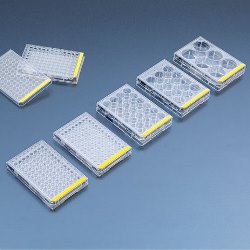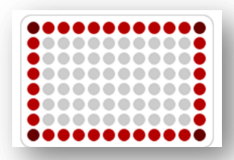 S2K Commerce - Products Dropdown
S2K Commerce - Products Dropdown
 S2K Commerce - Shopping Cart
S2K Commerce - Shopping Cart
 Web Content Viewer
Web Content Viewer
Eliminating Edge Effect in Cell Culture Plates

Edge effect is a longstanding burden for researchers of tissue and cell culture. Commonly observed in a 96 well plate, “edge effect” refers to the phenomena in which contents of the wells on the outside of the plate evaporate during incubation. Even a small loss of medium can significantly impact results – making this microscopic phenomena a rather large problem.
Many researchers have offered various methods to help plate cells evenly and eliminate edge effect. While some of these suggestions solve one issue, they do not solve them all. In fact, they may create new issues such as bacteria growth and unnecessary expense.
So, what is the answer?
Taking a Closer Look: Why Edge Effect is Problematic

The first and most obvious problem caused by edge effect is wasted space. When the outer wells of a plate are used for anything other than cell growth, 37.5% of the plate is wasted.
Most labs report the outer edge evaporates almost 100% outer edge evaporation. The next-closest row evaporates some – not as bad as the outer edge, but more than the second-closest row, and so on. This is a concentric issue that creates well-to-well variations in nutrient concentration, pH and, ultimately, cell growth. The resulting pH differences from well to well also affect gene and protein expressions.
The more inconsistent cell culture is, the more inconsistent Westerns, PCR/qPCR, ELISAs and other applications will be.
Finally, edge effect results in unnecessary expense. Whether a lab decides to purchase more expensive plates, added media and/or reagents, or the investment of additional time to combat inconsistent results, all of that comes with a cost in dollars and quality of research.
How to Prevent Edge Effect in Cell Culture
Conventional wisdom says there are five ways to solve edge effect in cell culture plates:
Suggestion #1: “Leave the outer wells blank.”
The problem: Unfortunately, this method does not solve any of the issues mentioned above. Leaving the outer wells blank limits the most significant evaporation, but doesn’t solve the concentric issue of evaporation on the next-closest row, the second-closest row, and continuing to the core. This method is also a waste of plastic.
In sum, this suggestion does not increase well-to-well consistency and will result in throwing away or using 37.5% more plates to achieve the same goal.
Suggestion #2: “Fill the outer wells with PBS, water or media, or buy unique plates.”
The problem: Filling the outer wells with PBS, water or media will help hydrate the plate and has been shown to limit evaporation, but comes with other drawbacks.
This method results in added expense and, in most cases, does not solve the problem of temperature gradients when stacking plates. The temperature and evaporation gradient will affect the pH of the media, which in turn affects gene and protein expression. If you use water to fill these wells, you could also be creating a breeding ground for bacteria.
Suggestion #3: “Don’t stack plates.”
The problem: When plates are stacked, the top and bottom plates are acclimating to 37oC faster than the middle plates – but incubator space is expensive. Any savings on plates will likely be offset by spending $5,000 to $10,000 on a new incubator.
The other main objection to this method is that most incubators are used by more than one researcher. If other researchers are stacking, their stack could still block air flow to your plates and affect temperature in the incubator.
Suggestion #4: “Buy products that create unique environments.”
The problem: These products are expensive and are not a realistic option for many researchers. Whether additional sealing films, better air flow incubators or other unique options, all of these come with a price tag, plus trial and error.
Suggestion #5: “Attempt to control pH.”
The problem: Again, this method is expensive and requires the investment of time through trial and error. There is a recent paper on controlling the pH in cell culture systems that seems promising, but still a wide variety of environments, cells, medias and other factors to consider.
The Best Plate for Cell Culture Microscopy

In 2012, the Environmental Protection Agency (EPA) was challenged with edge effect and imaging 96 well plates. Due to variations throughout the plate, some wells were overexposed while others were underexposed. After testing TPP plates against six different manufacturers, the results were clear: The other manufacturers averaged a 60% evaporation gradient across the plate.
For TPP, it was a uniform 10% evaporation across the plate.
TPP’s unique, advanced design allows air flow above and below stacked plates, and its optimal lid design achieves well-to-well uniformity. The biggest advantages of using the TPP 96 plates are:
- Use of all 96 wells.
This helps limit the amount of plastic used, and reduces waste of media and other reagents.
- Significantly better well-to-well and vessel-to-vessel uniformity.
In turn, this improves consistency and reproducibility of all downstream applications, which lowers waste and reduces long-term expense.
- Better gas and temperature uniformity.
Achieve greater uniformity within your plate, stack and incubator.
- The flattest growth surface anywhere.
TPP plates offer better cell growth and uniformity, reinforcing benefits #2 and #3.
- Other better, unique features.
In addition to the benefits above, TPP plates include: black alpha-numbers for easier working conditions; a writing label on the plate and lid that is temperature- and chemical-resistant; numbered and lettered wells for better working conditions; and an intelligent design that makes stacking easier to handle and less likely to tip over.
Let MIDSCI Help Eliminate Edge Effect in Cell Culture Plates
Founded in 1983, MIDSCI is the Midwest’s leading consultative partner for scientific researchers everywhere. MIDSCI offers a wide variety of lab equipment and scientific research supplies from the industry’s most respected brands. And to demonstrate our commitment to customer service, our phones are answered by REAL people who provide real-time answers.
Interested in bringing TPP 96 plates to your lab? Contact us today for a sample! Submit a request online, call us toll-free at 1 (800) 227-9997 or send an email to leads@midsci.com.
